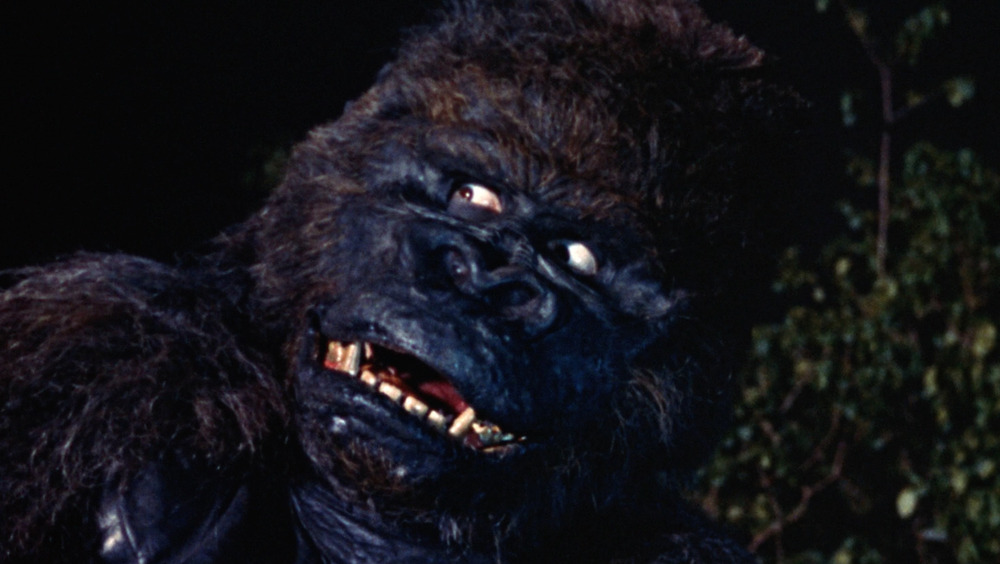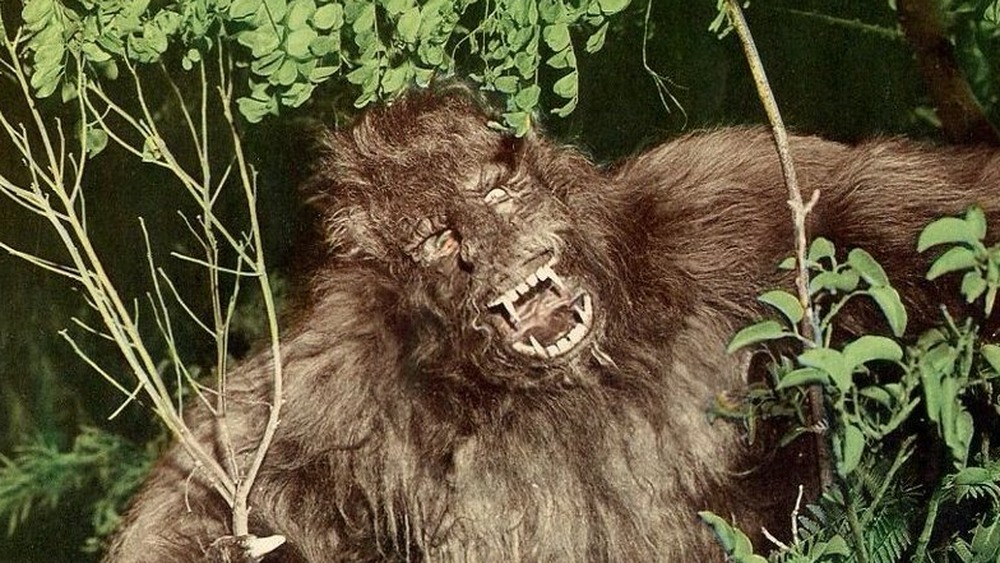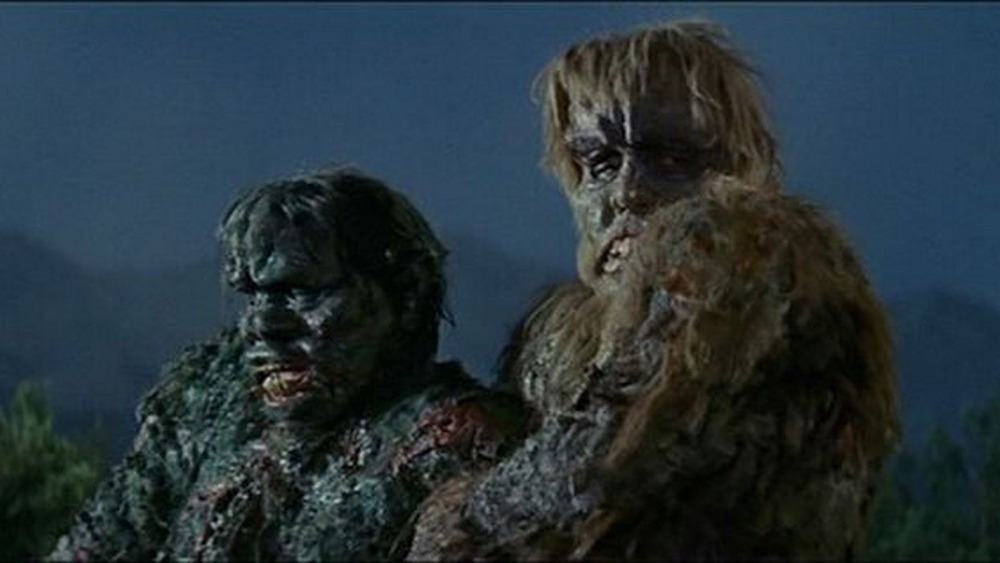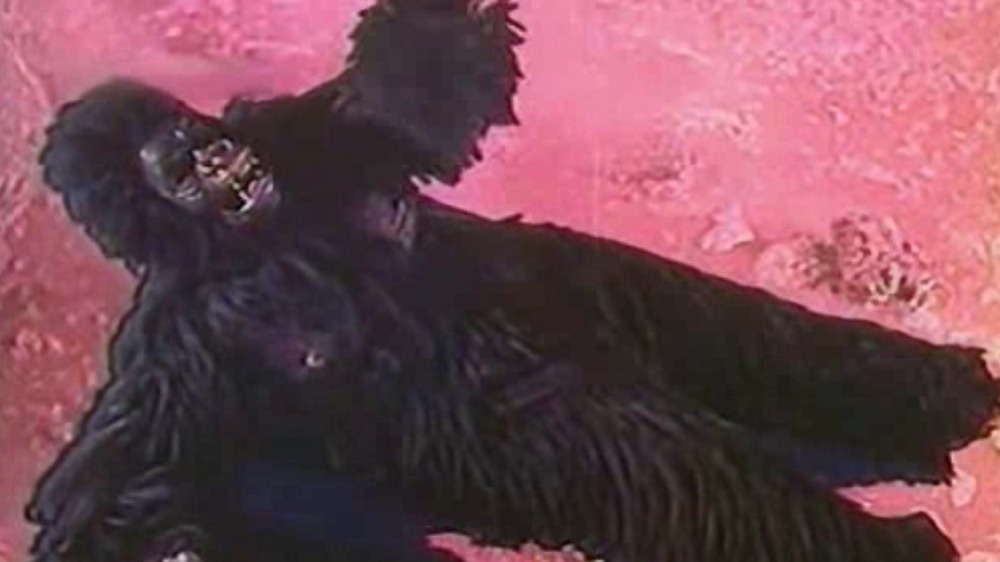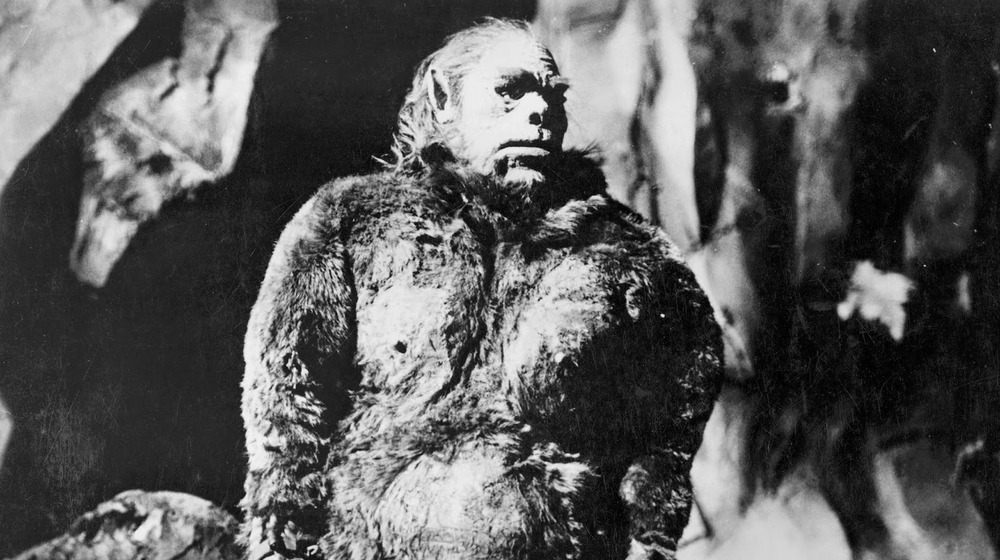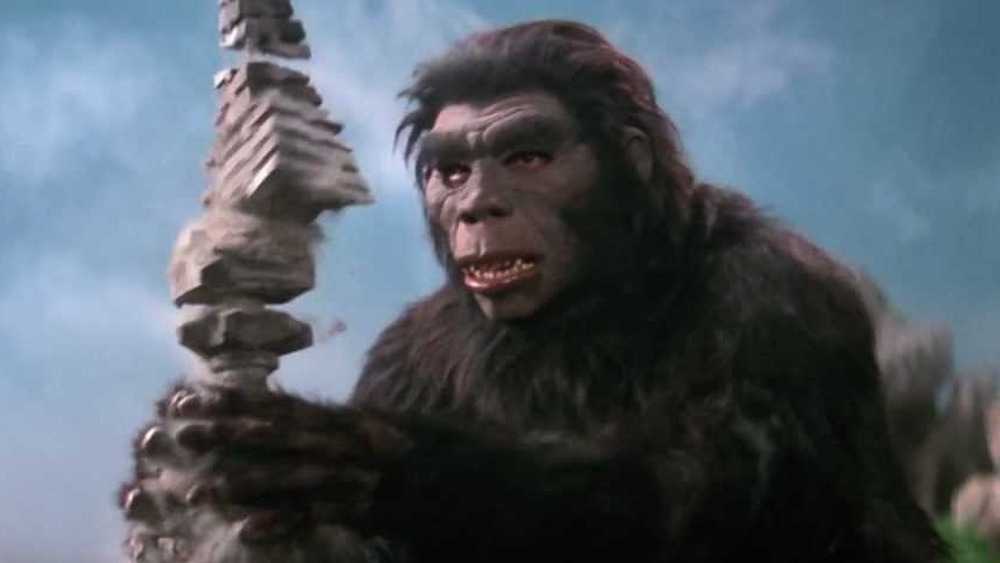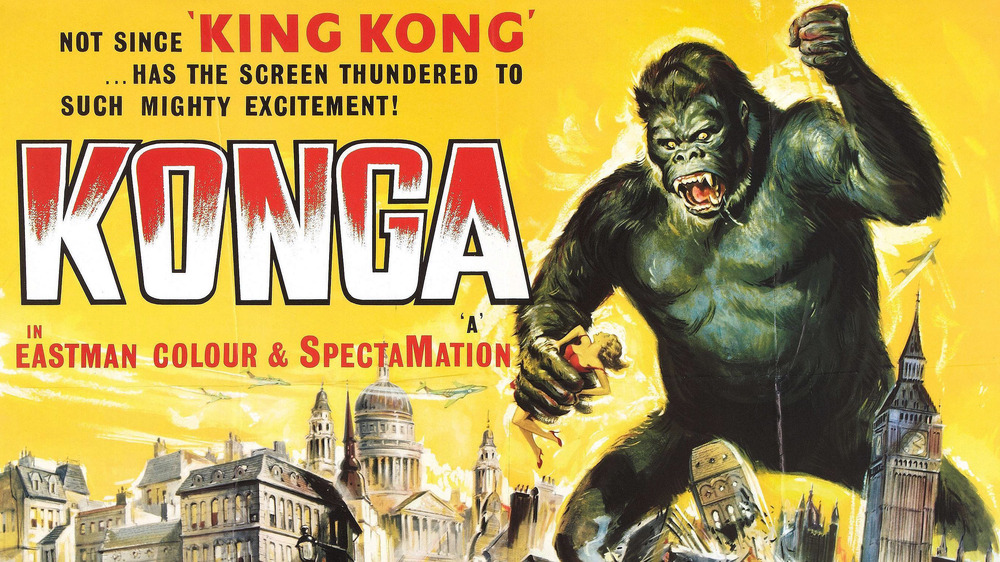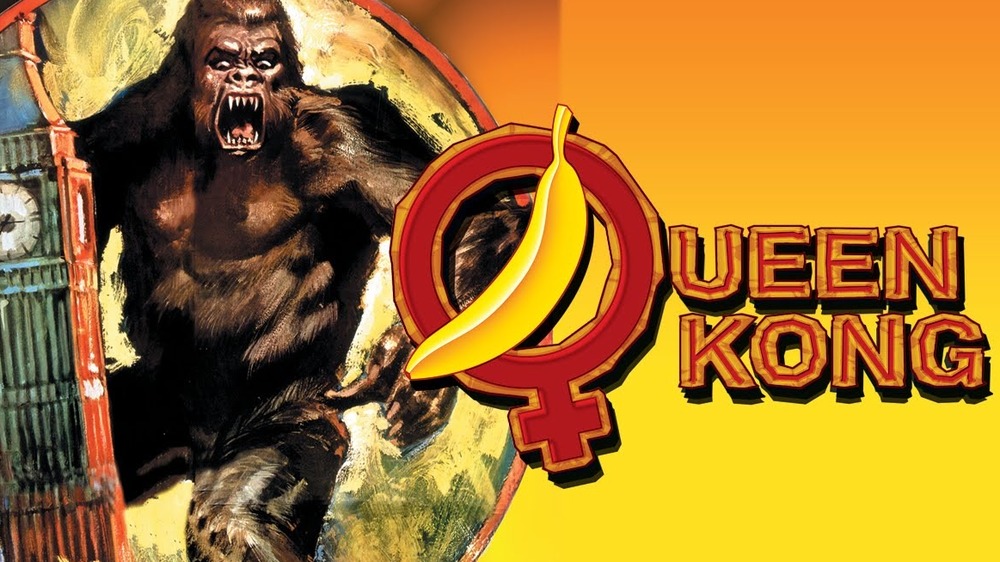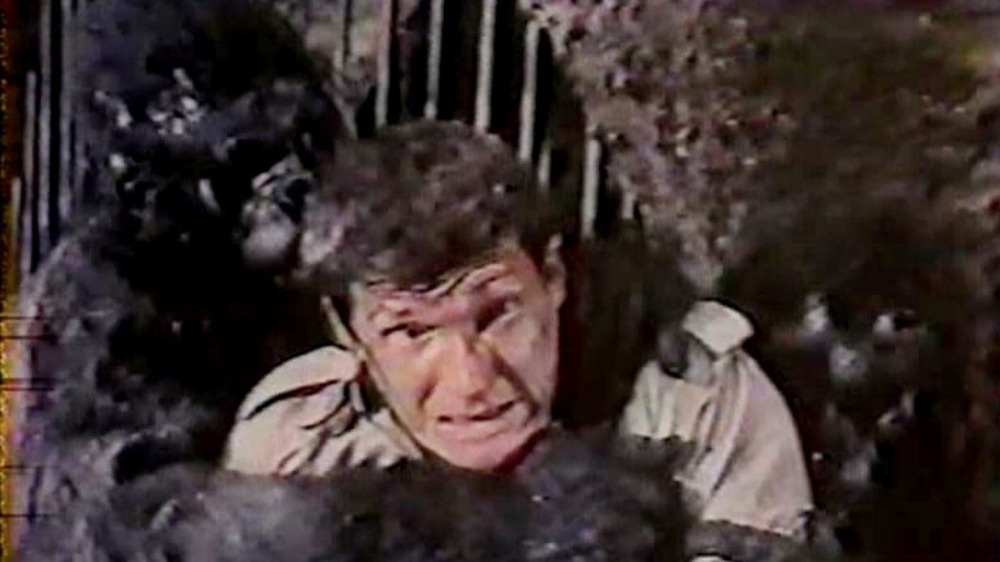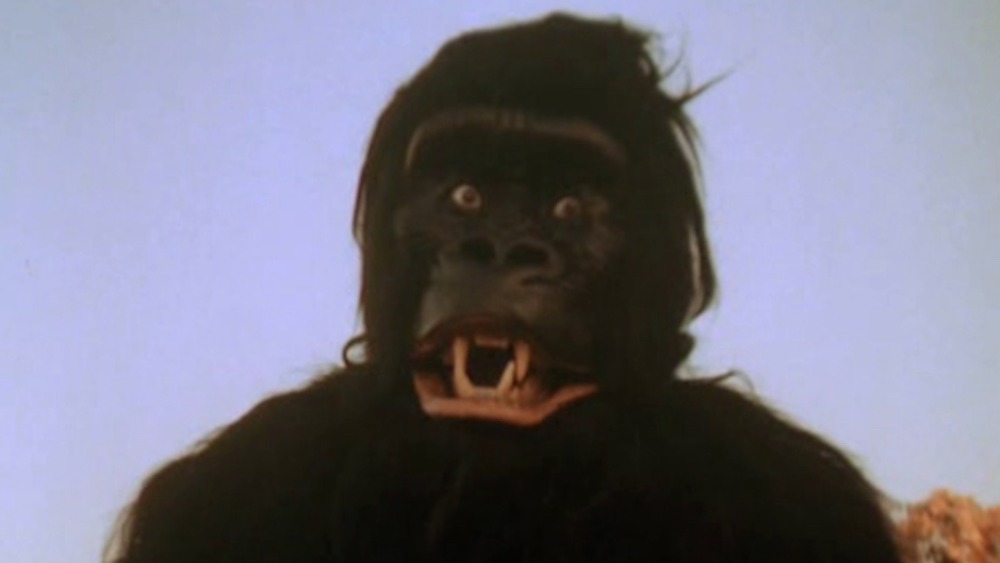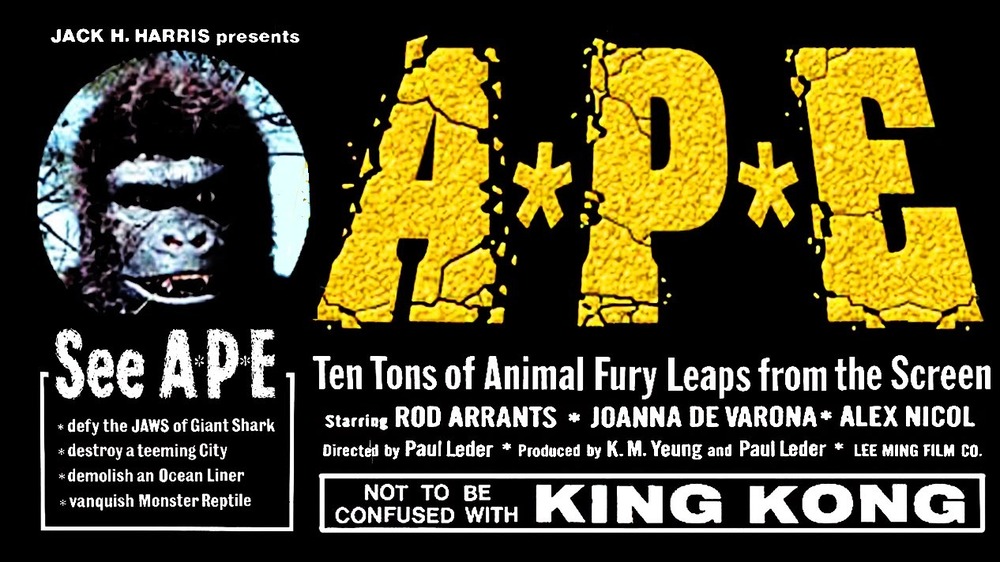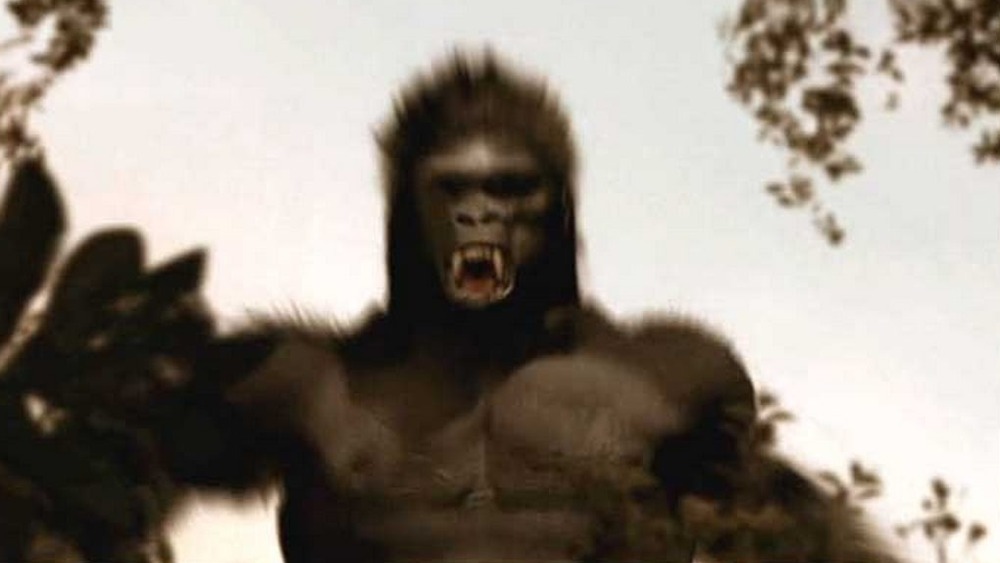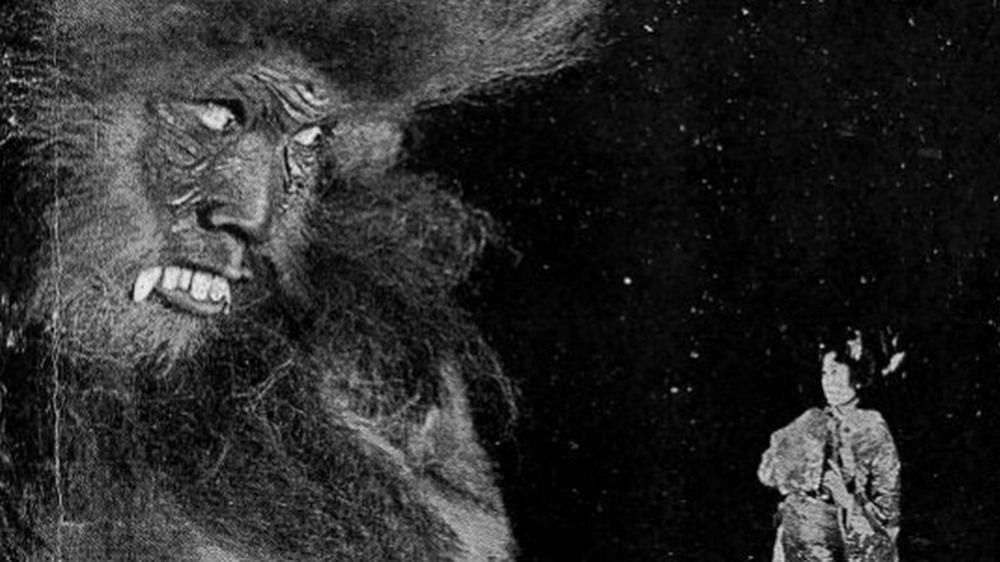Bizarre King Kong Ripoffs You Never Knew Existed
"We need Kong. The world needs him," insists Alexander Skarsgård's Nathan Lind in Godzilla vs. Kong. That's the 600-pound gorilla of understatements. Kong is good (monkey) business, based on the official Kong films – and the number of rip-offs from around the world. You know a concept has taken hold when everyone wants in (just look at the Godzilla series). Besides, the King Kong formula is simple: Giant Monkey. That's it. Sure, you can add in beautiful blondes, greedy tycoons, ferocious dinosaurs, even Robot Monkeys, but when it comes down to it, all you need is a giant primate-like creature who just wants some peace and quiet.
Naturally, every film on this list falls far short of the 1933 King Kong (or for that matter, Peter Jackson's 2005 remake and the Monsterverse's Kong), not only because the original is a cinematic masterpiece, but because most of these rip-offs are really bad. Bad as in "the filmmakers spent the entire budget on a used gorilla suit"-level bad. Almost every one is unwatchable, literally in some cases, as a few have even been lost forever. Whether you're hoping to avoid these monstrosities, or want to watch moviemakers slip on a proverbial banana peel, here are bizarre King Kong rip-offs you never knew existed!
Unknown Island replaces a giant gorilla with giant sloths
From the Universal monster movies to the Andy Rooney series, Old Hollywood churned out movies fast to feed content-hungry moviegoers in the days before TV. As soon as a series stopped making money, Hollywood stopped making them. So while King Kong was a critical and commercial smash in 1933, its sequel Son of Kong – which came only nine months later — was not, sending the Kong brand back to Skull Island (i.e. the studio shelf). Fifteen years later, B-level studio Film Classics, Inc. released Unknown Island, boasting this movie shot in Cinecolor was "Out Of This World!" Not how we would put it, but sure.
Unknown Island's story should sound familiar: An adventure seeker convinces his soon-to-be wife to finance an expedition to an island supposedly populated by dinosaurs; when they arrive, it turns out the legends were true! So yeah, same basic story as King Kong, although Unknown Island doesn't feature a gorilla, or gorilla-like, monster. Instead, it has giant sloths and actors in dinosaur costumes, resulting in stock footage you have probably seen somewhere else. Unknown Island isn't the worst King Kong ripoff, and at only 75 minutes it isn't a big time commitment either. Unknown Island is also in the public domain, so tracking it down should be much easier than charting a voyage to a mysterious island.
Toho ripped off Kong with The War of the Gargantuas
Brad Pitt said he discovered his love of cinema from Toho Studios' 1966 kaiju eiga The War of the Gargantuas, released to American cinemas in the 1970s. Most people didn't know what the hell he was talking about. But by the mid-1960s, Toho had already made one King Kong film, 1962's groundbreaking King Kong vs. Godzilla, and was set to release another, 1967's King Kong Escapes. In between Toho made the brilliantly bizarre King Kong ripoff, The War of the Gargantuas.
Gargantuas is actually a sequel to 1965's Frankenstein Conquers the World, in which a green-skinned, bolts-in-neck Frankenstein monster who is about 60 feet tall (because this is a Japanese monster movie) fights a fire-breathing dinosaur (also because this is a Japanese monster movie) to the death before he is carried into the sea by a giant octopus (in the Japanese version). Got all that?
In Gargantuas, the dead Frankenstein's DNA is used to create Sanda, a peaceful, brown, primate-like Gargantua (*cough* Kong rip-off *cough*) who escapes from his lab. His blood creates a mutated, murderous green Gargantua named Gaia. Despite being "brothers" (clones?), the Gargantuas go to war. It's a lot, but it's also pretty awesome. The Gargantuas have shown up from time to time in other Godzilla-related media, but there has never been a sequel, remake, or reboot. Here's hoping ol' Sanda and Gaia bring their hairy, scaly mugs to the Monsterverse. Brad Pitt could star!
Shikari was India's King Kong rip-off
India's Bollywood film industry is one of the biggest in the world, but that was most definitely not the case in 1963, when Shikari (meaning "hunter") was released. This may be the most impressive King Kong rip-off, not because it's good, but because the filmmakers didn't even try to disguise that it was a King Kong rip-off. The owners of a struggling circus set out to capture King Kong at Kong Island, so yeah, not exactly a subtle homage there. They are joined by a scientist, a beautiful girl, and a circus clown, perhaps inspiring 1964's Gilligan's Island.
Instead of Kong they encounter Otango, the result of experiments in turning humans into gorillas by the Island of Dr. Moreau-like mad scientist Dr. Cyclops...yes, that's his name. Sound crazy? It gets crazier. We won't spoil it, except to say Otango doesn't get nearly enough screen time, which is instead spent on the human leads, a complaint still made about monster movies today. Shikari isn't particularly memorable, though the soundtrack by composer G.S. Kohli became popular in India.
Half Human was "canceled"
Calling Half Human a "King Kong rip-off" may be inappropriate, as it's really an abominable snowman movie. Still, the monster and storyline from the 1955 film are suspiciously similar to King Kong – and the yeti looks like it could be a first cousin to Toho Studios' own Kong in 1962's King Kong vs. Godzilla. We're including it because the backstory is so interesting. Directed by Godzilla auteur Ishiro Honda, Half Human is about a yeti and his son who are worshipped by villagers in the Alps of Japan, when a ruthless tycoon sets out to capture the beasts. In development even before 1954's Godzilla, Half Human was soon banned after its initial Japanese release, was never released on home video, and has only been seen sparingly at festivals since.
The reason? According to Cool Ass Cinema, it's because of the movie's "alleged depiction of either the Burakumin people, or the Ainu aborigines as outcasts, deformed, and or psychopathic inbreds." So kinda like Deliverance with yetis? While the original Half Human is supposed to be unnervingly effective — albeit problematic — the only widely seen version is the dreadful 1958 American edition, which inserted scenes of Western actors, including longtime John Ford character actor and David Carradine's dad, John Carradine. Sadly, while 1955's Japanese Half Human isn't half bad, you're unlikely to ever see it, as it was canceled before that became a thing.
"King Kong Goes Hong Kong" in one of Quentin Tarantino's favorites
We wished we came up with "King Kong Goes Hong Kong," but alas that was how Celestial Pictures promoted 1977's The Mighty Peking Man. It's the most impressive part of this picture, which is King Kong if it were made by a 13-year-old boy. While every giant gorilla picture is a rip-off of the original King Kong, The Mighty Peking Man is technically a cash-grab of infamous schlockmeister Dino De Laurentiis' 1976 blockbuster King Kong remake, by another pair of infamous schlockmeisters, the Hong Kong-based Shaw Brothers Studio.
If you know Shaw Brothers Studio, you know what to expect. If you don't, it's basically an exploitation-era King Kong with thin plotting and a thick coating of 1970s sleaze. Even if you haven't seen it, you know what it's about: Explorers travel to an island to find a mythological monster and bring it back to civilization. It's King Kong but with Hong Kong replacing New York City, and a terrified Fay Wray being swapped for Peking Man's companion, a Russian blonde in a leopard-print bikini. The Mighty Peking Man was re-released in the late 1990s by Quentin Tarantino's Rolling Thunder Pictures, prompting a glowing three-star review from Roger Ebert. No, Ebert didn't actually think it was "good" and you won't either, but if you can track it down you'll love its delightfully kitschy absurdity all the same.
Konga brought a giant gorilla to England
Ever wonder what Michael Gough was up to before playing Alfred Pennyworth in the Tim Burton-Joel Schumacher Batman movies? Well, in 1961, he starred in one of the "better" King Kong rip offs, Konga. Better is a relative term here – Konga is still an embarrassment Gough probably wishes he never made, and you'll wish you never saw. What Gorgo is to Godzilla, Konga is to King Kong (Gorgo and Konga were even released in the same year), abandoning the original films' cities and contexts for Merry Old England.
Gough plays Dr. Charles Decker, who spent a year in Africa — where he was presumed dead — doing mad scientist-y things like turning plants and animals into giant monsters. Dr. Decker brings back a baby chimp, Konga, injected with his serum, to kill his enemies. But the baby chimp grows into a giant gorilla (we're not sure how that happened either) and causes destruction across London. Konga is a pretty basic cross between a "man-in-a-gorilla-suit" movie and the "monster run amok" pictures of the 1950s, trading giant ants, spiders, condors, and gila monsters with, well, a man in a gorilla suit. It's bad, but not quite laughably so, at least once you get used to the characters screaming bloody murder while being attacked by a dude in a cheap Halloween costume. We're glad to say that 28 years later, Gough graduated to another film about a guy in costume attacking people, Batman.
A female King Kong? Yas queen!
We're genuinely shocked it took 43 years for anyone to think of Queen Kong, though it actually was released before the movie it was ripping off, Dino De Laurentiis' King Kong remake. The American blockbuster remake came out December 17, 1976, while Queen Kong arrived on December 10, 1976, but only in Italy and Germany — Kong's then-copyright holder De Laurentiis stopped it from being released elsewhere.
Honestly, Queen Kong is less a rip-off and more of a spoof. The British-German co-production is a comedy adventure film and plays like a gender-reversed King Kong. A female film crew kidnaps a male actor and takes him to the jungles of Africa to star in a movie. There the actor, also a petty thief, becomes the object of desire for a giant female gorilla, who thirsts after him upon being taken to London. We applaud the effort, not the result. It wasn't beauty that killed the beast, but the critics, as its 23% audience score on Rotten Tomatoes and 3.3/10 score on IMDb demonstrate. Turns out that if you're going to make a comedy, it helps to be funny, which Queen Kong is not. In order to be "so bad it's good," a movie the film has to be unintentionally funny. Queen Kong is unintentionally not funny, which makes it just a bore. Maybe De Laurentiis did us a favor?
King of Kong Island rips off the audience
We gotta hand it to the film's American distributors, Better Television Distribution — they weren't even trying to disguise they were ripping off King Kong. Ironically, this movie doesn't feature a giant gorilla or even an island. Don't be fooled, however. While only the title rips off King Kong, the movie itself is basically Tarzan, if the Lord of the Apes were a lady. The original Italian title was Eva, la Venere selvaggia, which is translated as Eva, the Savage Venus.
This 1968 Italian jungle adventure film is about a mad scientist who is using mind control devices on gorillas in Kenya. When he kidnaps a young woman, a mercenary adventurer leads a team into the jungle to find her. Along the way he encounters a legendary "white jungle woman" wearing only a loincloth that the natives call The Sacred Monkey. Coolest hero name ever? Maybe.
The Sacred Monkey's actually an orphan named Eva who was raised by apes (sound familiar?), who speaks no human language, but can communicate with animals. Despite her name being in the Italian title, Eva is only a supporting character, as the focus is on the adventurer. So it's called Eva, The Savage Venus, but isn't about her, and was changed to King of Kong Island in America, but has no giant gorillas. Got it. Sounds like the ones getting ripped off the most were the people watching it.
The Mighty Gorga is mighty awful
There are bad special effects, horrible special effects, and then there's The Mighty Gorga. We can say with 100% certainty that you can spend $45 at your local Halloween Depot and create more convincing special effects than this. The storyline for the 1969 film pretty much is just King Kong: A showman short on cash travels to the African jungle to find an overgrown gorilla named Gorga. Once there, he's attacked by a Tyrannosaurus rex, who is killed by Gorga. There's something about a witch doctor and a volcano, yada, yada, but yeah, this is basically King Kong if it were filmed by a 12-year old who makes movies with a Super-8. The one "innovation" this film brings to the story is that the humans don't kidnap Gorga, and the big lug survives at the end. Ah, how sweet.
How do such blatant King Kong rip-offs keep happening? Well, because nobody really owns King Kong. As Flickering Myth explains: "The intellectual property status of King Kong has always been a grey area," going all the way back to Kong's creator Merian C. Cooper thinking he owned the rights, only to find out he only had the rights to the novelization (which expired and went into the public domain anyway). It's complicated. So if you want to make a Kong movie, you probably can, but have an attorney on standby. Can't cost any more than whatever The Mighty Gorga's production budget was.
A*P*E is the worst
A*P*E is the worst King Kong rip-off, though it only "wins" by a hair. With a 2.5/10 IMDB rating and a 9% audience score on Rotten Tomatoes, this movie stinks worse than an unwashed gorilla. A*P*E is a 1976 American-South Korean co-production, featuring a Western director and stars, and a largely South Korean crew, and was one of many giant gorilla movies made to ride the waves on Dino De Laurentiis' remake. "Not to be confused with King Kong" is even on the poster.
To give you an idea of what kind of movie you're dealing with, consider the title for its 1982 grindhouse theatrical re-release: Attack of the Giant Horny Gorilla. Honestly, it probably made more money with that title. There's also its signature scene, in which the gorilla flips the bird, which admittedly is pretty great.
A*P*E skips the whole "journey to a mysterious island" setup and starts aboard an oil tanker, where an imprisoned 36-foot tall gorilla escapes and immediately battles a giant great white shark (an unmistakable Jaws reference) before making its way to shore. The ape is at large, killing people across South Korea, stalking a beautiful blonde, and eventually getting blown away by the military. Wash-rinse-repeat. A*P*E is awful but short, so if you have 87 minutes to kill...honestly, you still probably shouldn't bother watching it.
Before Sharknado, The Asylum ripped off Kong
Both the original 1933 King Kong and the 1976 King Kong remake inspired plenty of rip-offs, but sadly Peter Jackson's epic 2005 remake didn't inspire nearly as many. Maybe that's because anyone knocking off another movie doesn't have the patience to sit through King Kong's nearly three-hour runtime. However, there was one noteworthy rip-off — 2005's King of the Lost World. Released by The Asylum, the cinematic masterminds behind the Sharknado franchise, King of the Lost World bills itself as a retelling of Sir Arthur Conan Doyle's The Lost World, but let's be honest, it's the kind of cash-grab mockbuster that The Asylum does best.
A crew crash lands in a remote jungle, where some are killed by giant scorpions, and some are brainwashed into performing a sacrificial ritual to appease the monsters that live there. Wouldn't you know it, King Ko — er, some giant gorilla, shows up to stop the ceremony. It's been a minute since we've read Doyle's book, but we don't remember any of this. Hey, creative license, right? Here's hoping The Asylum follows up Sharknado with Gorilla-Cane!
The three earliest Kong ripoffs were made in Japan -- and are lost forever
Japan was the first country to jump on the King Kong rip-off bandwagon with not one, not two, but three knockoffs released within five years of the original 1933 classic. King Kong proved so popular with Japanese audiences that movie studio Shochiku decided to remake it and just not bother asking RKO Pictures. Wasei Kingu Kongu (literally "Japanese King Kong") came out the same year as King Kong and was basically the same movie, but as a short subject with no sound (Japanese cinema was still silent in the 1930s). Five years later RKO re-released King Kong in Japan, so another studio ripped it off with King Kong Appears In Edo.
Nobody knows the 1938 film's plot and only a few stills survive, though "Edo" (Tokyo's original name) suggests it may have been a period film. Finally there's Kingu Kongu Zenkouhen, but even less is known about this film than King Kong Appears In Edo. There's a chance they're the same movie. Want to see them? We wish you could. Most pre-war Japanese movies are long gone, both due to deterioration and the Allied bombings during World War II. Two of those attacks, the atomic bombings on Hiroshima and Nagasaki, inspired another giant monster two decades later, Godzilla. While these two (or three) films are shameless King Kong rip-offs, they are also the earliest examples of the kaiju eiga genre Japanese cinema would become famous for.
